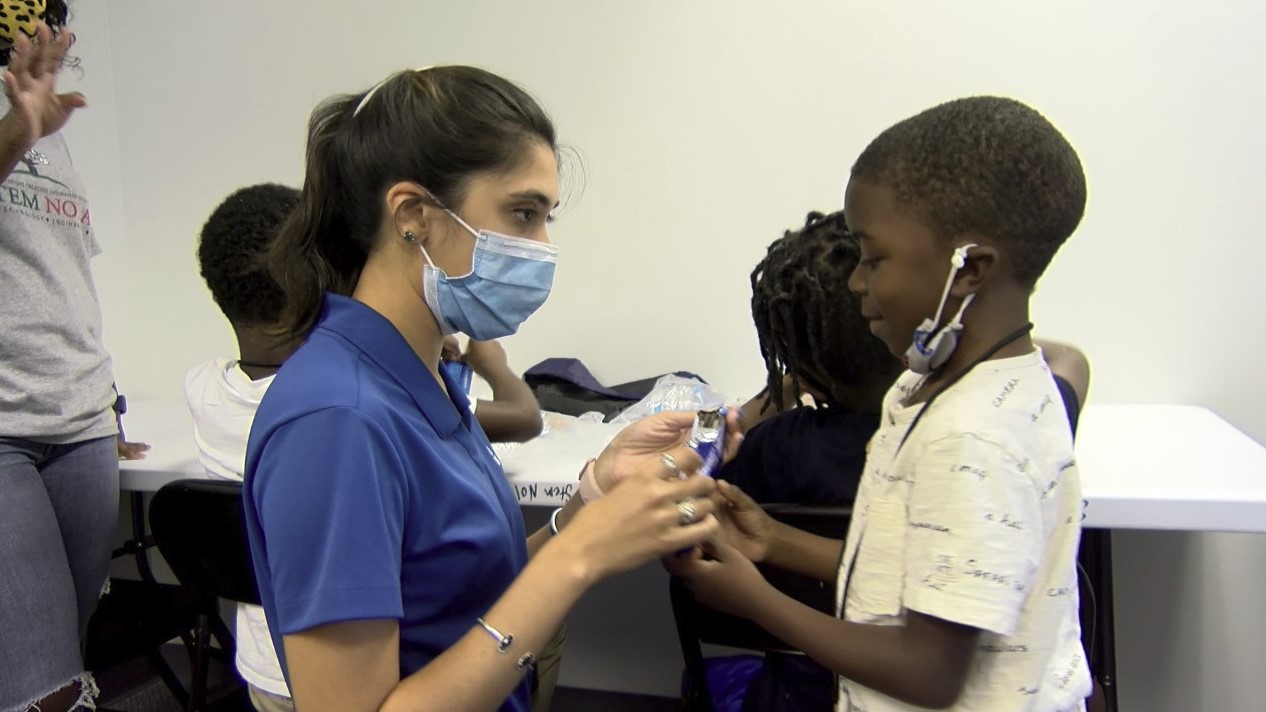This summer, Leah Brown looked on with a smile as students began seeing ice cream, one of their favorite treats, in a whole new light. Suddenly, making this sweet, creamy delight was helping unlock the mysteries of compounds and melting points. Discussion among the kids is rampant about the surprising role of salt in the reaction unfolding before them, as they excitedly witness science coming to life in a delicious dessert.
“STEM NOLA makes it real for the kids. They break down science and math principles and make it age appropriate,” says Brown, a Manager of Corporate Affairs at the Chevron Corporation, recalling one of her site visits to the New Orleans non-profit. STEM NOLA is a national leader in developing and implementing programming that teaches children grades K-12 science, technology, engineering and math (STEM) skills.
Since 2018, Chevron has supported STEM NOLA, contributing more than $335,000 to help the organization provide STEM education virtually during the pandemic and in-person at churches, schools and community centers in low-income neighborhoods. With the help of Chevron and other supporters, STEM Global Action (SGA), the parent organization with affiliates like STEM NOLA across the country and abroad, has impacted 100,000 children in the last eight years.
Brown says Chevron’s contributions are part of their mission of supporting organizations like STEM NOLA that advance STEM education.
“We believe that our social investments are a key part of the broader success that we seek to achieve as a corporation and as a business,” Brown says. “We truly feel that investing in STEM and organizations like STEM NOLA is critical to our future and to the nation’s future. As a company, we are committed. We believe that when you give children STEM skills, you are helping them to be more employable. And you’re giving them an opportunity that could be life changing, not only for them, but for future generations to come.”
As technology has advanced in recent years, STEM industries and careers have rapidly increased, but Blacks and Hispanics remain underrepresented. Data from the PEW Research Center shows that Hispanics are 17% of total U.S. employment, but only 8% of all STEM workers. And Black workers are 11% of all employed adults, but only 9% in STEM occupations, including just 5% in engineering and architecture jobs.


Brown says the hope is that engaging children at a young age will encourage them to focus on STEM subjects, and STEM careers. “I personally believe that STEM education can be an enabler in addressing the economic disparity and the wealth gap. Unfortunately, the percentage of people of color in STEM jobs correlates with the number studying STEM subjects at colleges and universities. We have to do our best to try and ensure that our young people are better prepared and have a desire to participate in STEM programs.”
Furthermore, Brown acknowledges that she is extremely passionate about STEM. “I am a recovering chemist,” she says, only half joking. “I say ‘recovering’ because, you know, you never actually get away from it. Once a scientist, always a scientist. I started off my career as a research and development chemist in the oil and gas industry. I’m still in oil and gas, but doing something a bit different. I have done many things over the course of my career. I also taught high school engineering. And my daughter is a chemical engineering major. We believe in STEM. “
Through her work with Chevron’s Gulf of Mexico Business Unit, the nation’s second largest oil company has supported other impactful non-profits, such as the Boys and Girls Club of Southwest Louisiana, the Lake Pontchartrain Basin Maritime Museum’s aquatic Robotics Summer Camp and the St. Tammany Parrish School system.
“We work with organizations on their STEM needs,” Brown says. “We try to meet all of our partners in the communities where they operate. Instead of coming in and trying to direct them, we work with them collaboratively, and ask, ‘Where do you see gaps within your population, your students and your teachers for teaching and learning?’ Then we try to provide the assistance to help them meet those challenges.”
One of her favorites has been working with the New Orleans “Fab Lab,” a partnership between Chevron and the Fab Foundation that provides participants with access to advanced tools and technology. The Fab Lab consists of a suite of digital fabrication and rapid prototyping machines including 3-D printers. Working with this cutting-edge technology, users gain experience in critical thinking, problem solving and expanding their analytical skills. The goal is to prepare them to be future innovators.
“Students, the community and small business owners can go in and use it,” she says. “It is a great resource for area.”
Brown says Chevron appreciates STEM NOLA because of their hand-on approach and the fact that they bring the STEM programing directly into neighborhoods and communities. “The students do not have to go a great distance to participate. It is also important that they care about diversity and inclusion, and ensuring that the participants, the mentors, the volunteers, are a diverse cross-section of the population. It’s critical that when children are interested in a career that they see professionals in that field who look like them.”
For Brown, old habits never end. She tries to visit STEM NOLA on occasions when their lessons are related to chemistry. “It’s always high energy to be there. The kids are happy to be there. They’re so excited. It’s almost like a birthday party kind of atmosphere, but they’re doing science, technology, engineering and math! Often kids think that science and math are not fun, but STEM NOLA proves that it can be. That is so very important.”
